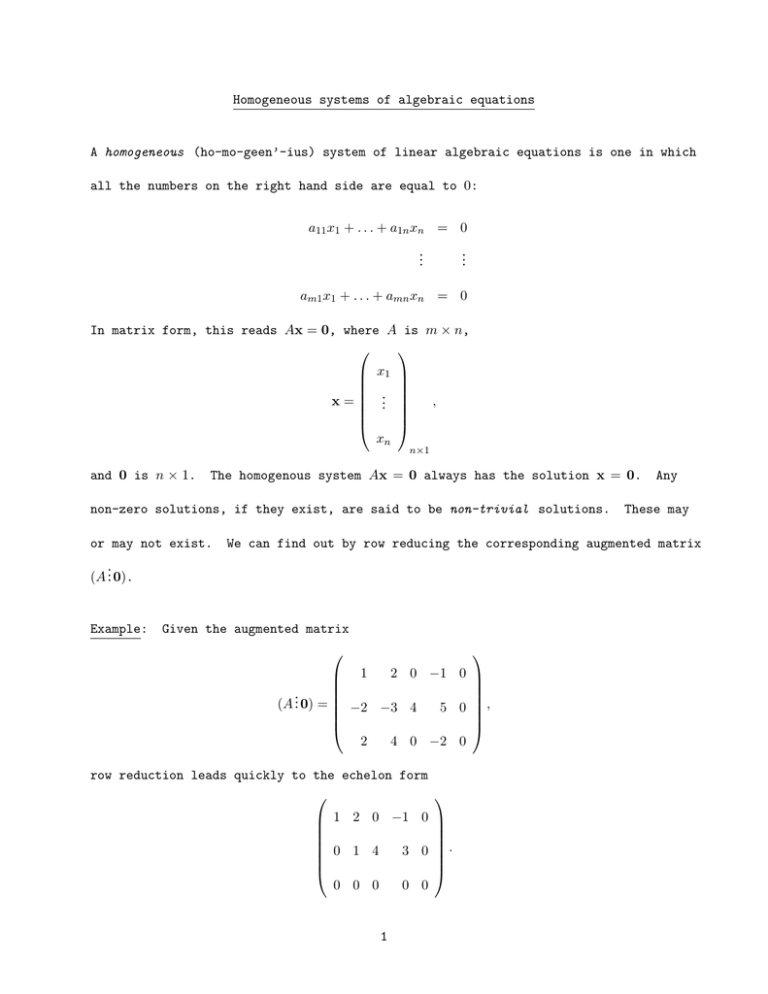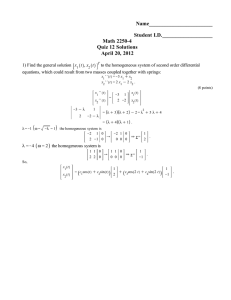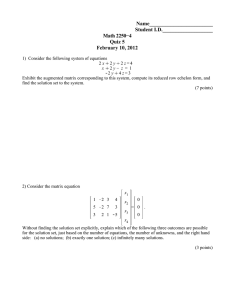Homogeneous systems of algebraic equations A homogeneous (ho
advertisement

Homogeneous systems of algebraic equations
A homogeneous (ho-mo-geen’-ius) system of linear algebraic equations is one in which
all the numbers on the right hand side are equal to 0:
a11 x1 + . . . + a1n xn = 0
.
.
.
.
.
.
am1 x1 + . . . + amn xn = 0
In matrix form, this reads Ax = 0, where A is m × n,
x=
and 0 is n × 1.
x1
.
.
.
xn
,
n×1
The homogenous system Ax = 0 always has the solution x = 0.
non-zero solutions, if they exist, are said to be non-trivial solutions.
or may not exist.
These may
We can find out by row reducing the corresponding augmented matrix
.
(A.
.0).
Example:
Any
Given the augmented matrix
2 0 −1 0
1
.
.
(A.0) = −2 −3 4
5 0
,
2
4 0 −2 0
row reduction leads quickly to the echelon form
1 2 0 −1 0
0 1 4
3 0
.
0 0 0
0 0
1
Nothing happened to the last column --- row operations don’t do anything to a column
of zeros.
In particular, doing a row operation on a system of homogeneous equations
doesn’t change the fact that it’s homogeneous.
For this reason, when working with
homogeneous equations, we just use the matrix A.
The echelon form of A is
1 2 0 −1
0 1 4
3
.
0 0 0
0
After the matrix has been put into echelon form, we can distinguish two different types
of variables.
The leading entries are in columns 1 and 2, and the variables corresponding
to these entries, namely x1 , x2 are called leading.
are, by default, free variables.
Variables which are not leading
In the present case, x3 and x4 are free variables,
since there are no leading entries in the third or fourth columns.
Continuing along,
we obtain the Gauss-Jordan form (You are working out all the details on your scratch
paper as we go along, aren’t you!?)
1 0 −8 −7
0 1
4
3
.
0 0
0
0
No further simplification is possible.
Meaning:
any further non-trivial rwo operations
will destroy the Guass-Jordan structure of the columns with leading entries.
system of equations reads
x1 − 8x3 − 7x4 = 0
x2 + 4x3 + 3x4 = 0,
2
The resulting
In principle, we’re done in the sense that we have the solution in hand.
However,
it’s customary to rewrite the solution so that its properties are more clearly displayed.
First, we solve for the leading variables:
x1 = 8x3 + 7x4
x2 = −4x3 − 3x4 .
Assigning any values we choose to the two free variables x3 and x4 gives us a solution
to the original homogeneous system.
"free".
This is, of course, whe the variables are called
We can distinguish the free variables from the leading variables by denoting
them as s, t, u, etc.
Thus, setting x3 = s, x4 = t, we can now rewrite the solution
as
x1 = 8s + 7t
x2 = −4s − 3t
x3 = s
x4 = t
Better yet, the solution can also be written in matrix form as
7
8
x1
−3
−4
x
2
+ t
= s
x=
0
1
x3
1
0
x4
We won’t do it here, but If we were to carry out the above procedure on a general homogeneous
system Am×n x = 0, we’d establish the following facts:
3
Properties of the homogenous system
for Amn
1. The number of leading variables is ≤ min(m, n).
2. The number of non-zero equations in the echelon form of the system is equal to
the number of leading entries.
3. The number of free variables plus the number of leading variables = n, the number
of columns of A.
4. The homogenous system Ax = 0 has non-trivial solutions only if there are free
variables.
5. If there are more unknowns than equations, the homogeneous system always has non-trivial
solutions.
Why?
This is one of the few cases where you can tell something about
the solutions without doing any row reduction.
6. A homogeneous system of equations is always consistent (i.e., always has at least
one solution).
Why?
Can you explain this geometrically?
There are two other properties:
1. If x is a solution to Ax = 0, then so is cx for any real number c.
Proof:
x is a solution means Ax = 0.
But Acx = cAx = c0 = 0, so cx is also
a solution.
2. If x and y are two solutions to the homogeneous equation, then so is x + y.
Proof:
A(x + y) = Ax + Ay = 0 + 0 = 0.
4
These two properties constitute the famous principle of superposition which holds for
homogeneous systems (but NOT for inhomogeneous ones).
Definition:
if x and y are two vectors and s and t two real numbers (scalars ), then
sx + ty is called a linear combination of x and y.
We can restate the superposition principle as:
Superposition principle:
if x and y are two solutions to the homogenous equation Ax =
0, then any linear combination of x and y is also a solution.
Remark:
This is just a compact way of restating the two properties:
solutions, then by property 1, sx and ty are also solutions.
sum sx + ty is a solution.
If x and y are
And by property 2, their
Conversely, if sx + ty is a solution to the homogeneous
equation for all s, t, then taking t = 0 gives property 1, and taking s = t = 1 gives
property 2.
You have seen this principle at work in your calculus courses.
Example:
Suppose φ(x, y) satisfies LaPlace’s equation
∂2φ ∂2φ
+ 2 = 0.
∂x2
∂y
We write this as
∆φ = 0,
where ∆ =
∂2
∂2
+
.
∂x2 ∂y 2
The differential operator ∆ has the same property as matrix multiplication, namely:
if φ(x, y) and ψ(x, y) are two differentiable functions, and s and t any two real numbers,
5
then
∆(sφ + tψ) = s∆φ + t∆ψ.
It follows that if φ and ψ are two solutions to Laplace’s equation, then any linear
combination of φ and ψ is also a solution.
The principle of superposition also holds
for solutions to the wave equation, Maxwell’s equations in free space, and Schrödinger’s
equation.
Example:
Start with "white" light (i.e., sunlight); it’s a collection of electromagnetic
waves which satisfy Maxwell’s equations.
Pass the light through a prism, obtaining
red, orange, ..., violet light; these are also solutions to Maxwell’s equations.
The
original solution (white light) is seen to be a superposition of many other solution,
corresponding to the various different colors.
The process can be reversed to obtain
white light again by passing the different colors of the spectrum through an inverted
prism.
Referring back to the example we just worked out, if we set
7
8
−3
−4
,
, and y =
x=
0
1
0
1
then the susperposition principle tells us that any linear combination of x and y is
also a solution.
In fact, these are all of the solutions to this system.
xh = {sx + ty : ∀ real s, t}
and say that xh is the general solution to the homogeneous system Ax = 0.
6
We write


